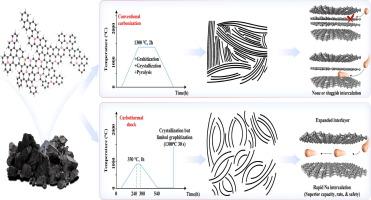动态控制结晶速率可使煤基硬碳高效储钠:近程有序结构和封闭孔隙的协同作用
IF 14.9
1区 化学
Q1 Energy
引用次数: 0
摘要
煤基硬碳具有成本效益高、产碳率高等优点,是一种很有前途的钠离子电池负极材料。然而,常规碳化会导致石墨化过度,导致层间间距不足(d002 < 0.37 nm)和封闭孔隙发育不全。在此,我们提出了一种通过碳热冲击处理(1300°C, 30秒)来解耦热力学和动力学约束的动态结晶控制策略。该方法可以精确调节石墨畴的有序动力学,产生具有扩展层间距(d002 = 0.385 nm)和均匀分布的封闭纳米孔的短程有序结构。通过原位表征和第一性原理计算相结合,我们阐明了三阶段结晶机制:(i)非晶碳转变,(ii)开孔崩塌,(iii)伪石墨有序。优化后的HC具有58.6%的初始库仑效率和204 mA h g−1的平台容量,同时其优化的层间间距降低了Na+扩散障碍,从而实现了卓越的速率能力(在0.5C下循环300次后达到221 mA h g−1)。实用袋电池在- 20°C下100次循环后保持85%的容量保留,并提供284 Wh kg - 1能量密度。本研究建立了易于石墨化前驱体的动力学调控范式,促进了高性能HC阳极的合理设计。本文章由计算机程序翻译,如有差异,请以英文原文为准。

Dynamic control of crystallization rate enables efficient sodium storage in coal-based hard carbon: synergistic effects of short-range ordered structure and closed pores
Coal-derived hard carbon (HC) represents a promising anode material for sodium-ion batteries owing to its cost-effectiveness and high carbon yield. However, conventional carbonization induces excessive graphitization, yielding insufficient interlayer spacing (d002 < 0.37 nm) and underdeveloped closed pores. Herein, we propose a dynamic crystallization control strategy through carbothermal shock treatment (1300 °C, 30 s) that decouples thermodynamic and kinetic constraints. This method precisely modulates graphite domain ordering kinetics, producing short-range ordered structures with expanded interlayer spacing (d002 = 0.385 nm) and homogeneously distributed closed nanopores. Through combined in situ characterization and first-principles calculations, we elucidate a three-stage crystallization mechanism: (i) amorphous carbon transformation, (ii) open-pore collapse, and (iii) pseudo-graphitic ordering. The optimized HC achieves record performance with 88.6 % initial Coulombic efficiency and 204 mA h g−1 plateau capacity, while its optimal interlayer spacing lowers Na+ diffusion barriers to enable exceptional rate capability (221 mA h g−1 at 0.5C after 300 cycles). Practical pouch cells maintain 85 % capacity retention after 100 cycles at −20 °C and deliver 284 Wh kg−1 energy density. This work establishes a kinetic regulation paradigm for graphitization-prone precursors, advancing the rational design of high-performance HC anodes.
求助全文
通过发布文献求助,成功后即可免费获取论文全文。
去求助
来源期刊

Journal of Energy Chemistry
CHEMISTRY, APPLIED-CHEMISTRY, PHYSICAL
CiteScore
19.10
自引率
8.40%
发文量
3631
审稿时长
15 days
期刊介绍:
The Journal of Energy Chemistry, the official publication of Science Press and the Dalian Institute of Chemical Physics, Chinese Academy of Sciences, serves as a platform for reporting creative research and innovative applications in energy chemistry. It mainly reports on creative researches and innovative applications of chemical conversions of fossil energy, carbon dioxide, electrochemical energy and hydrogen energy, as well as the conversions of biomass and solar energy related with chemical issues to promote academic exchanges in the field of energy chemistry and to accelerate the exploration, research and development of energy science and technologies.
This journal focuses on original research papers covering various topics within energy chemistry worldwide, including:
Optimized utilization of fossil energy
Hydrogen energy
Conversion and storage of electrochemical energy
Capture, storage, and chemical conversion of carbon dioxide
Materials and nanotechnologies for energy conversion and storage
Chemistry in biomass conversion
Chemistry in the utilization of solar energy
 求助内容:
求助内容: 应助结果提醒方式:
应助结果提醒方式:


